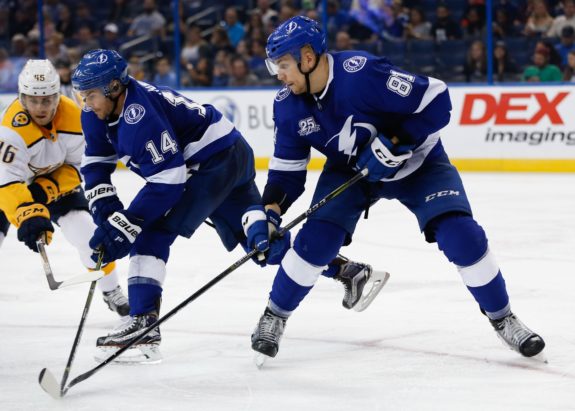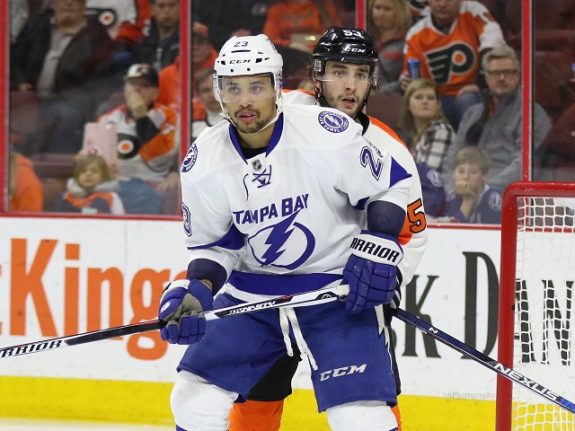During the 2016-17 season, the Syracuse Crunch went on a deep playoff run, taking them all the way to the Calder Cup Final. Despite their success, however, Lightning GM Steve Yzerman had to retool nearly the entire Crunch roster due to an influx of drafted talent from juniors. Just a few weeks after falling to the Grand Rapid Griffins, Yzerman was clearing space on the Crunch’s roster to make room for their new professional players. By the start of the 2017-18 season, the Crunch had 10 rookie players taking the ice, many of whom were high draft picks for the organization.

Three weeks into the season, the Crunch looked like a lost cause. While the team certainly was talented, they made mistakes expected from a team mostly consisting of rookies. With inconsistent scoring and mediocre goaltending, the Crunch appeared to have a long season of growing pains ahead of them. After starting off 4-10-1, it was clear that something needed to change in order to salvage the season.
Righting the Crunch’s Ship
This slow start prompted Yzerman to trade two of the Crunch’s veteran players, goaltender Michael Leighton and forward Tye McGinn, to Arizona for goaltender Louis Domingue. While Domingue had struggled with a bad Arizona team, Yzerman felt that he could help stabilize the shaky Crunch goaltending.
After acquiring Domingue, the Crunch immediately went on a 10-game winning streak then followed that up with a seven-game streak just a few weeks later. During these steaks, the Crunch went from a team making rookie mistakes to a group capitalizing on their skill-sets. Even with veterans like Domingue and Cory Conacher earning NHL call-ups, the Crunch have continued to win in impressive fashion.
In their last four games, the #SyrCrunch allowed just three total goals, outscoring their opposition, 14-3.
Weekly No. 15 → https://t.co/Mt2jwo71RM pic.twitter.com/3BzqzuVcPm
— Syracuse Crunch (@SyracuseCrunch) January 16, 2018
With their recent surge in play, the Crunch have put themselves firmly back into the playoff hunt. While they are third in their division, the Crunch have done nothing but gain ground on the top teams in the AHL. If this play continues, the team will comfortably make the playoffs and look to win the Calder Cup one year after reaching the final.
Crunch Players Rising to the Challenge
If you look purely at point totals, the Crunch are a very balanced team. Their current scoring leader, Matthew Peca, has eight goals and 31 points on the season. After Peca, seven players scored 20 or more points, with four of the seven being AHL rookies. No one player is scoring all the goals either, as their top goalscorer, rookie Mitchell Stephens, only 13 goals in 39 games. Success is coming from all forwards chipping in on the scoresheet instead of one player driving the majority of the offense.
It’s not only the Crunch’s rookies who are making an impact on the team, though. Adam Erne, the Lightning’s second-round pick in 2013, is second in scoring behind Peca with 12 goals and 26 points. Carter Verhaeghe, whom the Crunch acquired in the offseason for goaltender Kristers Gudlevskis, is one of the top scorers in Syracuse. Verhaeghe had no fanfare when he was brought in, with little more expectation than being a veteran presence on the team. Now, the 26-year-old center is ready to eclipse his career-high points total not long after the half-way point in the season.

This trend of veteran players performing above expectations also applies to the Crunch’s top scoring defensemen. Both Jamie McBain and Mat Bodie were veteran signings brought in to help mentor the Crunch’s young defensive corps. Not only do the veteran defensemen appear often on the scoresheet, they act as alternate captains for the Crunch. These two have provided a consistent and valuable veteran presence for the young team.
Where Does the Future Fall for the Lightning?
With all of this positive news coming out of Syracuse, it begs the question… how do these young players fit into the Lightning’s future? As a franchise, the Lightning have the majority of their core wrapped up in long-term contracts. With only a few unsigned core players, the Lightning’s top scoring lines will likely look similar for the next four to five years. However, as contracts expire for veteran players, there is going to be upheaval along the bottom half of the Lightning’s roster.

For starters, the Lightning only have two defensemen signed past the 2018-19 season. With core players like Anton Stralman, Braydon Coburn and Dan Girardi all set to become free agents in 2019, the Lightning will have a number of open roster spots for defensemen. This lines up remarkably well with the Crunch’s young defensemen like Dominik Masin, Ben Thomas and Erik Cernak who should ready to take on the NHL by 2019. Even if the Lightning decide to bring in free-agents or resign Stralman, the team will have the flexibility to bring up cost controlled rookies for those seasons if need be.
Lining up the Crunch’s Forward Class
With a vacant roster spot left after J.T. Brown was claimed by Anaheim, the Lightning appear ready to give one of their minor leaguers a chance to impress in the NHL this season. It seems likely that either Peca or Erne will be brought up to fill Brown’s spot on the roster, with both players having seen short NHL stints in the past. If Peca or Erne are able to stick with the Lightning’s bottom pairing, it would keep Yzerman from having to trade for additional forward support before the playoffs, while giving a young player needed time in the NHL.

The future of the Crunch’s’ forward class lines up in a similar fashion for Tampa Bay. By the time Kucherov and Brayden Point are holding shiny new contracts for the 2019-20 season, the Lightning will only have six forwards signed for the year. This leaves Yzerman a lot of room to call-up the current and future class of Crunch forwards out of training camp. With two more years of professional experience and development under their belts, many of Crunch’s currently impressive rookies should be ready to take on the NHL by 2019.
Lightning Keeping It Cost-Controlled
For the Lightning, the future success of the team rests on the current success of the Syracuse Crunch. In a salary cap world, controlling costs in any form is a necessity for survival. By 2019, the Lightning will need as many talented, cost-controlled forwards and defensemen that they can muster to keep their roster of star players intact. Even if only a handful of the current AHLers are ready by then, it still gives the Lightning some talented, cost-controlled options to fill in their roster. By turning around their 2017-18 season, this group of young Crunch players is showing that they will be more than ready to take on the NHL when that time comes.